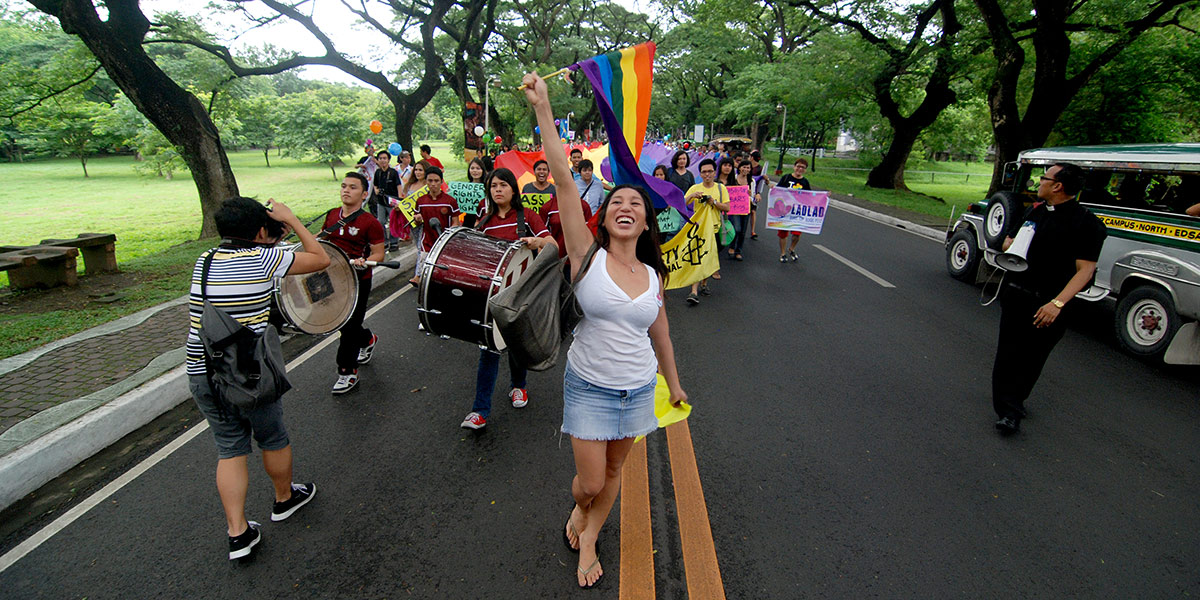
“A working-class citizen becoming a political leader for the people” may sound like an overdone movie plot, but “a middle-class transgender woman running for Congress as head of the world’s first LGBT political party” is real life. In their newest film, Out Run, Cinema Assistant Professor Johnny Symons and S. Leo Chiang document the journey of Bemz Benedito, the first trans woman to run for Philippine congress as the face of LGBT political party, Ladlad — a Tagalog word which translates to “come out” or “unfurl,” as with a cape.
Out Run is traveling and garnering buzz on the international film festival circuit with screenings in Hawaii, Sweden, Taiwan, Australia, Scotland, New York and more; it won Best Cinematography at the Los Angeles Asian Pacific Film Festival.
“An artistic political doc, Out Run is both riveting and familiar, as the leaders (including Bemz Benedito, a trans woman who serves as the face of the party) deftly employ campaign strategies that include everything from transforming beauty parlors into headquarters to forming alliances on the local level — even if it means supporting other candidates in quid pro quo moves,” Filmmaker Magazine writes.
A country with Catholic roots touching centuries-old soil, many in the Philippines see the acceptance of LGBT individuals as going against the moral grain. Out Run follows the individuals who are trying to turn that tide; during filming in 2013, the members of the party included Benedito, Raymond Alikpala and Danton Remoto, along with supporters Santy Layno and Bhuta Adelante. Although visibility of the LGBT community is more prominent in the Philippines than in the United States, it does not necessarily translate to more progressive outcomes.
The LGBT community — especially the transgender part of the community — is still trapped inside a stereotypical box, Layno says, a trans woman and former sex worker and beauty pageant contestant. She explains that influential LGBT individuals are only accepted in the mainstream as entertainers, and trans women are seen as flamboyant subjects of ridicule.
Ladlad aims to bring LGBT awareness, not only of their presence, but the entire scope of LGBT capability and potential. As the film shows, the members and supporters of Ladlad work hard to prove their gumption in the political arena by driving an aggressive grassroots campaign all over the Philippine Islands.
Symons and Chiang originally wanted to make a documentary about LGBT politicians outside the western world, filming candidates in Nepal and Kenya. But when those stories folded, the duo looked to the Philippines.
Shooting a documentary always has its difficulties, but filming in an unfamiliar country posed unique challenges for Symons and Chiang, who did not know the culture or speak the language.
“[Chiang] grew up in Taiwan; I grew up in the U.S.,” Symons says. “There was a lot we didn’t know culturally and linguistically. … Manila is an enormous and incredibly densely populated city, and traffic is insane.”
Although most Filipinos speak English, Symons recalls that one of the hardest parts of production was filming in a room full of Tagalog conversations and not knowing what was important enough to capture. As a result, they captured it all and waded through hours of footage with a translator to parse what was relevant to the narrative.
“This is an unusual trans story and I think that, in many ways, it strengthens it,” Symons says. “A lot of the trans stories that we see are about transition, but this a post-transition story and the characters are very clear about what their gender or orientation is; they’ve moved past that. [They] want to become leaders nationally and represent people not only in the [LGBT] community but their people.”
He emphasizes, “It isn’t a story about being trans, it’s a story about being a leader.”
It was a tandem two-man show during filming; Chiang shouldered the bulk of the camera work, but sometimes concurrent events would require Symons to keep a camera in Manila while Chiang took one on hours-long bus rides to film other subjects. A number of SF State students and alums also worked on the project in various production and editing capacities. The list includes Ryan White, Brian Favorite, Bernardo Josue, Glenn Aquino, Chan Yok, Daniel Chein, Candy Guinea, Caio Simbula, Garret Navalta and Francesca Gerin del Carmen.
A number of organizations funded Out Run, including ITVS, Sundance Institute Documentary Film Program and Tribeca All Access. Additional funding through a grant was provided by SF State’s Office of Research and Sponsored Programs.
Symons directs the Queer Cinema Institute at SF State. Both he and Chiang have personal stakes in this film as gay men, but what does Out Run mean now in the context of today’s sociopolitical climate? “I think Out Run is one of many stories that is important to get out there because it shows complexity and intersectionality of people’s lives. It shows the lives of trans people of color which is a population clearly not well-understood by the president-elect.”
On a broader note, Symons speaks of the need to build bridges for a brighter future.
“We’re facing an era where there is heightened political divisions in this country and a lot of misunderstanding,” he says. “What we need are portraits of humanity where we can see that people’s lives are not as black and white or clear cut as we think they are, and I mean that from both sides.”
— Gospel Cruz
Links
Photo: Activist Santy Layno leads a procession waving the pride flag, 2012. Photo by Dondi Tawatao.